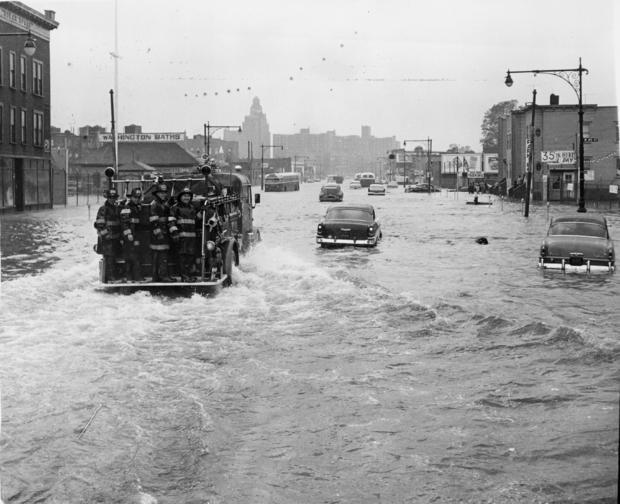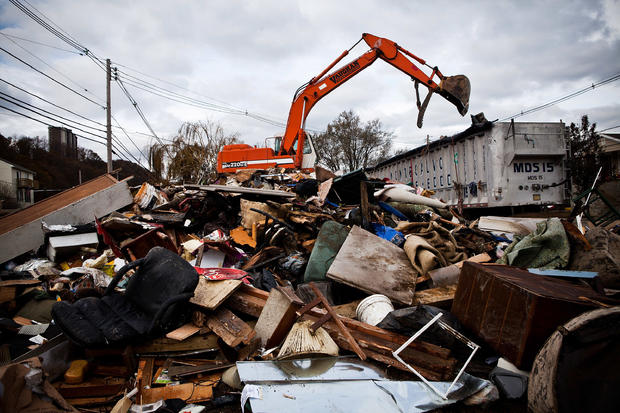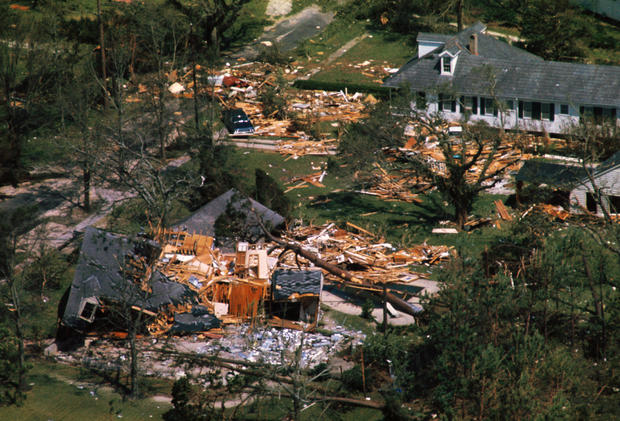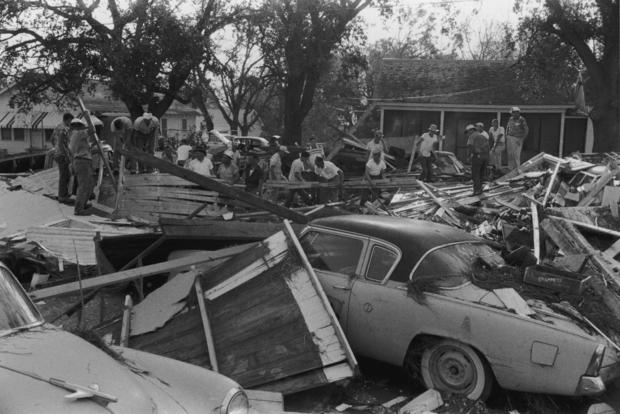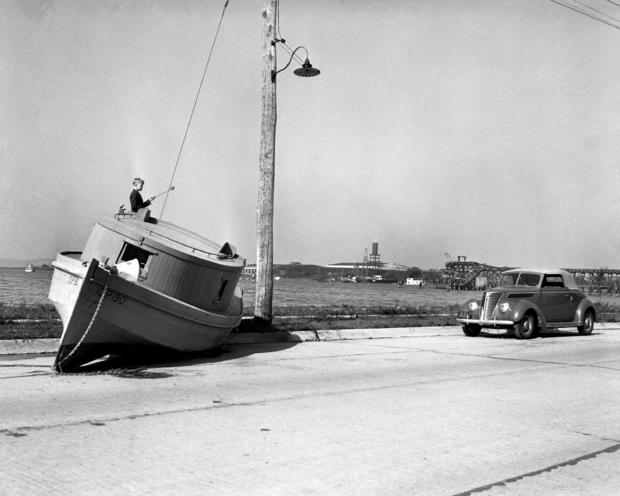The new hurricane season is underway, with the National Oceanic and Atmospheric Administration forecasting as many as nine storms this year, including one to four major hurricanes.
Climate change is making matters worse, resulting in heavier rainfall and stronger winds. Most recently, Hurricane Ian, the Category 5 tempest that ripped through southwest Florida last year with 150 mph winds, killed 150 people and caused tens of billions of dollars in property damage.
Here are some of the most destructive and deadly hurricanes ever to touch U.S. soil.

15. Hurricane Donna (August 1960)
Category 4: 130-156 mph wind speeds
Deaths: 114
Property damage: $387 million
Donna is the fifth-strongest hurricane ever to hit the U.S. and is the only one to produce hurricane-force winds across Florida, the Mid-Atlantic and New England in the same storm, according to NOAA.
Donna began near the western coast of Africa in Cape Verde, traveled northwest for five days across the Atlantic Ocean and unleashed its wrath on the Leeward Islands. It then continued north to Puerto Rico, where it killed more than 100 residents, before hitting the Bahamas and finally touching down in the Florida Keys. Along its path, Donna destroyed parts of eastern North Carolina, Long Island in New York and Block Island in Rhode Island.
14. Hurricane Agnes (June 1972)
Category 1: 74-95 mph wind speeds
Deaths: 122
Property damage: $2.1 billion
Agnes whipped up in Mexico’s Yucatan Peninsula, traveled east into the Caribbean Sea, then veered north to the Gulf of Mexico. It touched land in the Florida Panhandle and also hit Georgia. From there, Agnes tore through eastern North Carolina and finished in New York City. It caused major flooding in Virginia, the Carolinas and New York.
13. Hurricane Ian (September 2022)
Category 4: 130-156 mph wind speeds
Deaths: 150
Property damage: $112 billion
NOAA has described Ian as the most costly hurricane in Florida’s history and the third-most expensive in U.S. history in terms of property damage. The hurricane began off the western coast of Africa, then gathered force as it traveled across the Atlantic for six days. In the Caribbean Sea, Ian turned north and struck Cuba and the Gulf of Mexico. In the U.S., it made landfall in Cayo Costa, Florida, and continued to spread carnage across the Carolinas. More than 100 Floridians died from Ian’s destruction.
12. Hurricane Sandy (October 2012)
Category 2: 96-110 mph wind speeds
Deaths: 233
Property damage: $50 billion
Sandy formed in the Caribbean Sea, then gained intensity and speed in traveling north across Jamaica, Cuba and the Bahamas. It continued northeast and made landfall near Atlantic City, New Jersey. Sandy, which at one point stretched 900 miles, damaged 24 states. In New York City, it caused a storm surge that flooded streets and the subway system, leading to widespread power outages. All told, the hurricane caused flooding, high winds and mudslides that took families years to recover from.
11. Hurricane Camille (August 1969)
Category 5: 157 mph+ wind speeds
Deaths: 256
Property damage: $1.4 billion
Camille formed in the Caribbean just west of the Cayman Islands. It moved west, struck parts of Cuba, then turned north toward the Gulf of Mexico and made landfall on the Mississippi coast. In Mississippi, Camille’s barometric pressure reached nearly 27 inches, making it the second-most intense hurricane in U.S. history.
Most of Camille’s devastation happened as it moved further west through Tennessee, Kentucky, West Virginia and Virginia. While passing over the Virginias, it dumped as much as 20 inches of rain in some areas, causing flash floods.
10. Hurricane Audrey (June 1957)
Category 4: 130-156 mph wind speeds
Deaths: 390
Property damage: $150 million
Audrey began in the Gulf of Mexico, traveled north and made landfall in the U.S. at the Texas-Louisiana border. In its brief pass through Louisiana, the hurricane created a storm surge of 8 to 12 feet in the southwest part of the state. Most of Audrey’s destruction happened after it traveled inland. It carried strong winds and heavy rain into northern Mississippi and the Great Lakes region, killing hundreds along the way.
9. Great Atlantic Hurricane (September 1944)
Category 3: 112-129 mph wind speeds
Deaths: 390
Property damage: $100 million
This hurricane began in the Caribbean Sea directly northeast of the Leeward Islands. It traveled northwest and hit landfall in Cape Hatteras, North Carolina. The storm continued north on its path of destruction, tearing through parts of Long Island, New York, and Point Judith, Rhode Island, and dumping nearly a foot of rain on cities such as Hartford, Connecticut. NOAA said 46 people died on land from the Great Atlantic Hurricane and another 344 were killed while aboard five ships, including a U.S. Navy destroyer.
8. Florida Keys Labor Day Hurricane (August 1935)
Category 5: 157 mph+ wind speeds
Deaths: 408
Property damage: $6 million
This hurricane began in the central Bahamas, moved west and gained strength after moving across Andros Island. It continued northwest and slammed the Florida Keys, where it did most of its damage and killed hundreds of World War I veterans. The storm weakened as it made its way up the state’s west coast, falling to a Category 2 when it hit Cedar Key. The hurricane eventually made its way to Norfolk, Virginia, then petered out over the Atlantic Ocean.
7. New England Hurricane (September 1938)
Category 3: 112-129 mph wind speeds
Deaths: 600
Property damage: $308 million
This hurricane earned the nickname the “Long Island Express” because of the havoc it wreaked on the northeastern United States. It began in the Atlantic, grew stronger as it moved west and hit Puerto Rico, most likely as a Category 5 hurricane, NOAA said. The storm then turned north and arrived in the U.S. in Cape Hatteras, North Carolina. Continuing north, it was downgraded to a Category 3 once it hit Long Island, New York, and parts of Connecticut. The heavy rainfall caused flooding of the Connecticut River and surges in Narragansett Bay and Buzzards Bay.
6. Sea Island Hurricane (August 1893)
Category 3: 120 mph wind speeds
Deaths: 1,000
Property damage: $1 million
The Sea Island Hurricane formed in the Atlantic Ocean, generating its might as it traveled west toward the Caribbean Sea near the Lesser Antilles islands. It then headed north, through the Bahamas, dragging a fury of heavy winds across the Sea Islands — a group of isles along Florida, Georgia and South Carolina. The Sea Island Hurricane moved up the Atlantic coast and eventually made landfall in Savannah, Georgia.
Sea Island was one of the most devastating storms in South Carolina’s history, helping plunge Beaufort County into an economic decline.
5. Cheniere Caminada Hurricane (October 1893)
Category 5: 130 mph wind speeds
Deaths: 1,100
Property damage: $5 million
Cheniere Caminada formed in the Caribbean Sea, moved northwest toward the Gulf of Mexico, then made landfall Cheniere Caminada, Louisiana — a fishing town east of Grand Isle. The hurricane continued west and struck Mississippi, tearing through 500 miles of coastline between both states. It also caused destruction in Georgia and the Carolinas.
All told, Cheniere Caminada damaged ships and destroyed parts of towns and crops. It was the second deadliest storm in Louisiana history behind Katrina.
4. Hurricane Katrina (September 2005)
Category 4: 157 mph+ wind speeds
Deaths: 1,207
Property damage: $75 billion
Weather experts call Katrina the most costly hurricane in U.S. history, with the storm laying waste to New Orleans, the Mississippi coast Alabama, and parts of Miami-Dade and Broward counties in Florida.
The hurricane formed in the Caribbean Sea just southeast of the Bahamas, then traveled northwest to Florida and made landfall in Broward County. It turned west, gaining strength as it traveled across the Gulf of Mexico, before returning to land at 125 miles per hour in Buras, Louisiana. All told, Katrina generated about 10 to 14 inches of rain over Florida and 8 to 12 inches of rain along the northern Gulf coast. It also caused 33 tornadoes, NOAA said.
3. San Felipe-Okeechobee Hurricane (September 1928)
Category 4: 130-156 mph wind speeds
Deaths: 2,166
Property Damage: $75 million
The San-Felipe-Okeechobee Hurricane is widely regarded as one of the most destructive hurricanes of all time. This storm began over the Atlantic, gained momentum while passing over the Leeward Islands and then smashed into Puerto Rico. From there, it ventured northwest through the Bahamas, building even more force, and made landfall in Palm Beach, Florida. The worst damage took place in Lake Okeechobee, Florida, where it caused storm surges of up to 9 feet. The hurricane eventually dissipated after barreling through eastern North Carolina and parts of the Great Lakes region.
2. Hurricane Maria (September 2017)
Category 4: 150 mph wind speeds
Deaths: 2,975
Property Damage: $90 billion
Maria began in the Indian Ocean then moved westward across the Atlantic Ocean, gaining speed and power along the way. Its first land target was the Caribbean island of Dominica, on which it unleashed 23 inches of rainfall. Maria then turned north and slammed into Puerto Rico, causing widespread destruction, including power outages that lasted for months. Experts estimate that more than 1,000 people in Puerto Rico were killed as a result of the storm, according to a 2017 New York Times report
The hurricane continued north along the Atlantic Ocean shoreline, striking Cape Hatteras, North Carolina. It eventually traveled further north to Cape Race, Newfoundland, before dissipating in the Atlantic.
1. Galveston Hurricane (August 1900)
Category 4: 130-156 mph wind speeds
Deaths: 8,000
Property damage: $30 million
The Galveston Hurricane was the deadliest weather disaster in U.S. history, according to NOAA. The storm system formed over the Atlantic, and traveled to the Gulf of Mexico, while picking up strength and speed. It hit landfall in Texas, just south of Galveston. Its power tore across the Great Plains, then weakened as it traveled northeastward through the Great Lakes, New England and southern Canada.

